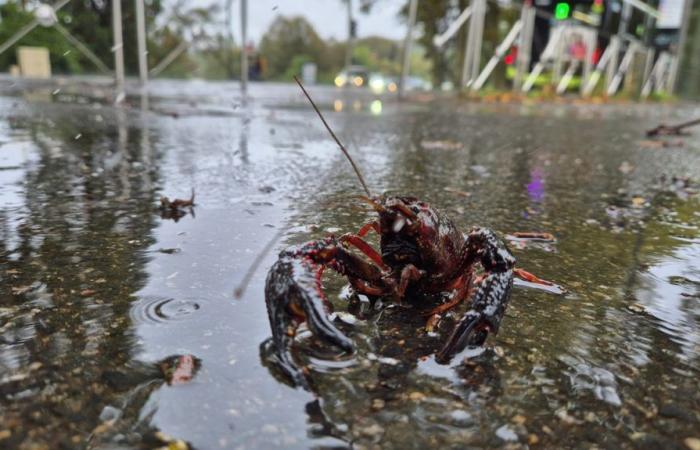
How far will the Louisiana crawfish go? Detected for the first time in 2004 in Indre-et-Loire, the crustacean imported from America in the 1970s is now one of the invasive exotic species that colonize our waterways. Without really effective means to limit its proliferation, local biodiversity stakeholders can only observe the damage.
“In twenty years, we can say that it has reached a stage of high density”brush Grégoire Ricou, researcher at the Indre-et-Loire Fishing Federation. The Louisiana red crayfish is present today in the main rivers such as the Cher, the Vienne, the Creuse or the Indre, in secondary rivers such as the Manse, the Claise or the Amasse, but also in smaller streams and a growing number of bodies of water, its preferred environment. We even encountered her on an expedition on the asphalt near Petit-Cher, in Tours, on a day of heavy rain. “Very humid periods like those we have just experienced allow it to move better to colonize new environments”predicts this seasoned observer of aquatic environments.
A threat to local biodiversity
It is not the only crayfish of American origin to be present: that of California and the American are also among the exotic invasive species recorded in the region. But the Louisiana red is the least discreet and above all the most prolific. “It can reproduce twice a year and lays more than 200 eggs”describes Colleen Bade-Vraie, study manager on invasive species at the Centre-Val de Loire Conservatory of Natural Spaces.
Opportunistic and omnivorous, it feeds on insect larvae, worms and plants, attacking plant layers which serve as habitat and egg-laying sites for fish. The galleries it digs into the banks weaken the environment. And, above all, as a “healthy” carrier of crayfish plague, it represents a danger for the native crayfish, known as “white-clawed”.
Introduced in France for breeding in 1976, the Louisiana crayfish is recognizable by its red-gray to bright red color and the red tubercles on its claws.
© (Photo archives NR)
“The population of the very sensitive white-clawed crayfish has already halved over the last twenty years due to the decline in environmental and water quality, remarks Grégoire Ricou. Crayfish plague can decimate remaining populations quickly. » The latter, included on the red list of globally threatened species and critically endangered in Center-Val de Loire, is therefore directly threatened with extinction by its American cousin. Especially since attempts to regulate the proliferation of Louisiana crayfish have so far not proven successful.
Towards a commercial sector?
Experiments with the introduction of carnivorous fish into bodies of water, trapping or targeted poisoning – as in the Brenne regional natural park – are just making it possible to limit its expansion. “She is unstoppable, considers the study manager of the fishing federation. Today, we must above all limit the contamination of new environments as much as possible during transfers of fish or by people who would be tempted to put them in their pond. » Like any invasive species, “its transport and detention are subject to strict conditions”recalls Colleen Bade-Vraie. It can be consumed, provided it is killed before transport.
The idea of creating a sector to fish and consume it on a large scale is even continuing in Brenne, where its proliferation has become uncontrollable. In Indre-et-Loire, it would be appreciated by fishermen from Lac de Peupleraies… And by otters. “It’s certainly a significant source of protein for them”underlines Grégoire Ricou. A boon for this protected species, which is making its return to the department after years of absence. From there to say that the Louisiana crayfish also has positive effects on biodiversity?





